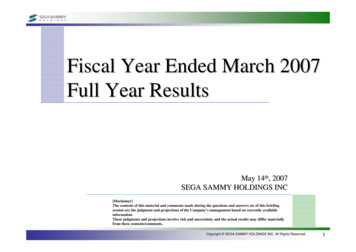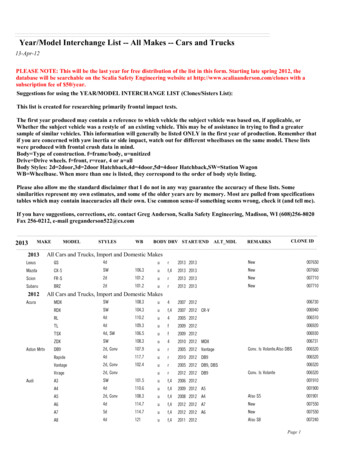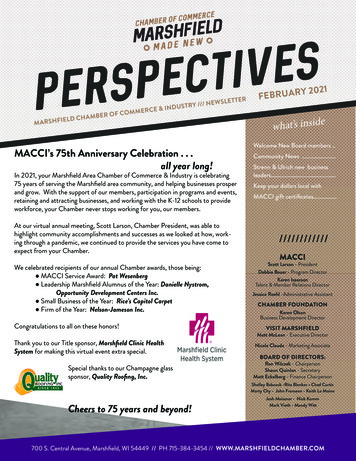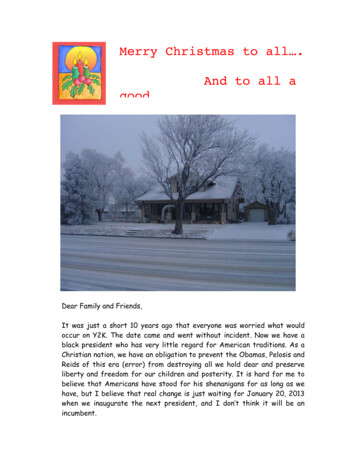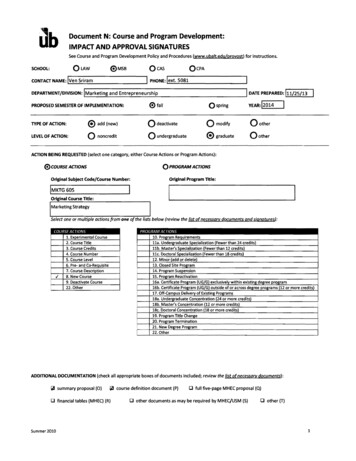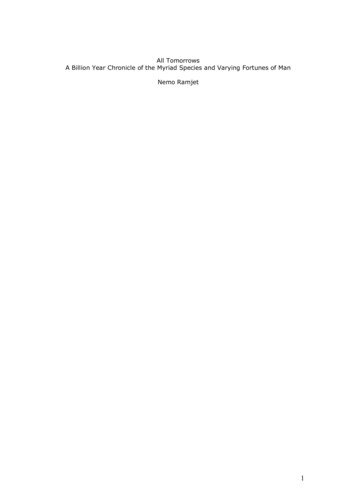
Transcription
All TomorrowsA Billion Year Chronicle of the Myriad Species and Varying Fortunes of ManNemo Ramjet1
2
To MarsAfter millennia of earthbound foreplay, Mankind’s achievements on a noteworthylevel began with its political unification and the gradual colonization of Mars. While thetechnology to colonize this world had existed for some time, political bickering, shiftingagendas and the sheer inertia of comfortable, terrestrial usurping had made this stepseem more distant than it actually was.Only when the risks clearly began to present themselves, only when Earth’senvironment began to buckle under the strain of twelve billion industrialized souls, didMankind finally take up the momentous task.All through the decades, traveling to, and later settling on Mars had beenenvisioned as quick, relatively easy affairs; complicated but feasible and manageable inshort term. As the push finally came to a shove, it was realized that this was not thecase.It had to go step by step. Atmospheric bombardment by genetically-tailoredmicrobes slowly generated a breathable atmosphere in a cycle that took centuries. Later,a few cometary fragments were knocked off-course to bring forth seas, oceans; water.When the wait was finally over, remnants of Earth’s flora and fauna were introduced asspecially-modified Martian remakes.When everything was ready, people came from their crowded world. They came inone-way ships; fusion rockets and atmospheric gliders, packed to the brim with colonists,sleeping in dreams of a new beginning.The first steps on Mars were taken not by astronauts, but by barefoot children onsynthetic grass.3
A lander ferries the first people to the pre-terraformed eden of Mars.4
The Martian AmericansFor several hundred years Mars remained as a backwater; prospering but still dimcompared to the splendor of Earth, which was glowing brighter than ever before. Thanksto the relocation of environmentally demanding industries to Mars, Earth could usurpeverything, without having to damage its tired biosphere. This was the TerrestrialHeyday; the climax of economic, cultural and social development on old Earth.This, however, was not to last. Like the gradual separation of America from herColonial mother, the governments of Mars adopted a new, Martian identity. They becamethe Martian Americans.The difference between Earth and the Mars was not only political. A fewgenerations in the lighter gravity gave the new Americans a spindly, lithe frame thatwould look surreal in their old home. This, combined with a certain amount of geneticengineering, took the Martians’ separation to a new level.For a while the silent schism between the two planets was mutually accepted, andthe balance of power hung in an edgy equilibrium. But the Terra-Martian standoff did not,could not last forever. With limitless resources and an energetic population, Mars wasbound to take the lead.5
6
Civil WarThe Martian turnover was expected to occur in two ways; either through long-termeconomical gains or by a much shorter but painful armed conflict. For almost twohundred years, the former method seemed to take effect, but this gradual stretcheventually did break in a most destructive way.Almost since its establishment, Martian culture was suffused with an explicittheme of rebellion against Earth. Songs, motion pictures and daily publications repeatedthese notions again and again until they became internalized. Earth was the old, ossifiedhome that held humanity back, while Mars was new; dynamic, active and inventive. Marswas the future.This ideology eventually reached its semi-paranoid, revolutionary apex. Roughly athousand years from now, the nations of Mars banned all non-essential trade and travelwith Earth.For Earth, it was a death sentence. Without the resources and industries of Mars,the Terrestrial Heyday would quickly devolve into a pale shadow of its former glory. Sincea trade of essential goods continued, nobody would starve. But for every citizen of Earth,the Martian boycott meant the loss of up to three fourths of their yearly income.Earth had no choice but to reclaim its former privileges, by force if necessary.Centuries after her political unification, Terra geared up for war.Most thinkers (and fantasists) of previous times had imagined interplanetary waras a glorious, fast paced spectacle of massive spaceships, one-man fighters and lastminute heroics. No fantasy could have been further from the truth. War between planetswas a slow, nerve-wracking series of precisely timed decisions that spelled destruction onbiblical scales.Most of the time the combatants never saw each other. Most of the time thecombatants were not there at all. War became a duel between complicated, autonomousmachines programmed to maximize damage to the other side while trying to last a littlelonger.Such a conflict caused horrendous destruction on both sides. Phobos, one of Mars’moons, was shattered, and rained down as meteorite hail. Earth received a polar impactthat killed of one third of its population.Barely escaping extinction, the peoples of Earth and Mars made peace and reforged a united solar system. It had cost them more than eight billion souls.7
Star PeopleThe survivors agreed that massive changes were necessary to ensure that such awar never occurred again. These reforms were so comprehensive that they entailed notpolitical, economical but biological changes as well.One of the greatest differences between the people of the two planets was thatover time, they had almost become different species. It was believed that the solarsystem could never completely unify until this discrepancy was overcome.The answer was a new human subspecies, equally and better adapted not only toEarth and Mars, but to the conditions of most newly terraformed environments as well.Furthermore, these beings were envisioned with larger brains and heightened talents,making them greater than the sum of their predecessors.Normally, it would be hard to convince any population to make a choice betweenmandatory sterilization and parenting a newfangled race of superior beings. However,memories of the war were still painfully fresh, and it was easier to implement theseradical procedures in the wake of such slaughter. Any resistance to the birth of the newspecies did not extend beyond meager complaints and trivial strikes.In only a few generations, the new race began to prove its worth. Organized as asingle state and aided by the technological developments of the war, they rapidlyterraformed and colonized Venus, the Asteroids and the moons of Jupiter and Saturn.Soon however, even the domain of Sol grew too small. The new people whoinherited it wanted to go further, to new worlds under distant stars. They were to becomethe Star People.8
9
Colonization and the Mechanical OedipiEven for the Star People, interplanetary travel was a momentous task. Early mindshad boggled over the problem and fantasies such as faster than light travel andhyperspace emerged as the only “solutions”.Simply put, it was impossible to take a large number of people with enoughsupplies to even the closest star to make colonization feasible. The existing technologiescould only slug along at mere percentages of lightspeed, making the journey an epochspanning affair. Enormous “generation ships” were conceived and even built, but thesesuccumbed to technical difficulties or on-board anarchy after a few cycles.The solution was to first go there, and make the colonists later. To this end, fastand small, automated ships were sent forth to the stars. On board were semi-sentientmachines programmed to replicate and terraform the destination, and “construct” itsinhabitants from the genetic materials stored on board.A bizarre problem plagued such attempts. The first generation of humans to bemanufactured sometimes developed a strange affection for the machines that madethem. They rejected their own kind and perished after the massive identity crisis thatfollowed. This technological Oedipus complex was not uncommon; nearly half of all thecolony-founding attempts were lost through it.Even then, however, the remaining half was enough to fill Humanity’s own spiralarm of the galaxy.10
The Summer of ManRight after Mankind’s colonization of the galaxy came its first true golden age.Reared by machine prophets, the survivors of the Oedipal plagues built civilizations thatequaled and even surpassed their Solar forbears.This diffusion across the heavens did not mean a loss of unity. Across the skies,steady flows of electromagnetic communication linked Mankind’s worlds with suchefficiency that there was no colony that did not know about the goings on of her distantsiblings. The free-flow of information meant, among other things; a vastly acceleratedpace of technological growth. What couldn’t be figured out in one world was helped outby another, and any new developments were quickly made known to all in a realm thatspanned centuries of light.Not surprisingly, living standards rose to previously unimaginable levels. Whilethis did not exactly mean a galactic utopia, it was safe to say that people of the colonizedgalaxy lived lives in which labor; both menial and mental, was purely compulsory.Thanks to the richness of the heavens and the toil of machines, each person had accessto material and cultural wealth greater than that of some nations today.During all this development, a curious phenomenon was observed. While alien lifewas abundant in the stars, no one had encountered any signs of true intelligence. Someattributed this to an overall rarity, while others went as far as divine influence;resurrecting religion.Regardless of the theorizing, one question went truly and utterly unanswered.What would really happen, if mankind ever ran into his equals or superiors in space?11
Two star people watch a holographic movie as they lounge under the remnants of theircolonized world’s indigenous flora. For them, it is a life of continual bliss.12
An Early WarningDuring those times, a small discovery of immense implications warned humanitythat it might not be alone.On a newly colonized world, engineers had stumbled across the remains of apuzzling creature, considered so because it had every hallmark of terrestrial animals onan alien planet. Justifiably named Panderavis pandora, the colossal fossil belonged to abird-like creature with enormous claws. Later research determined it to be a highlyderived therizinosaur, from a lineage of herbivorous dinosaurs that died out millions ofyears ago on Earth.While every other large land animal on that colony world had three limbs, acopper based skeletal system and hydrostatically operated muscles; Panderavis was atypical terrestrial vertebrate with calcium-rich bones and four extremities. Finding it therewas as unlikely as finding an alien creature in Earth’s own strata.For some, it was irrefutable proof of divine creation. The religious resurgence,fueled at first by mankind’s apparent loneliness in the heavens, got even moreintensified.Others saw it differently. Panderavis had shown humans that entities; powerfulenough to visit Earth, take animals from there and adapt them to an alien world, were atlarge in the galaxy. Considering the time gulf of the fossil itself, the mysterious beingswere millennia older than humanity when they were capable of such things.The warning was clear. There was no telling what would happen if mankindsuddenly ran into this civilization. A benevolent contact was obviously preferred and evenexpected, but it paid to be prepared.Silently, humanity once again began to build and stockpile weapons, this time ofthe interplanetary potency. There were terrible devices, capable of nova-ing stars andwrecking entire solar systems. Sadly, even these preparations would prove to beineffectual in time.13
A reconstruction of Panderavis shows the creature’s rake like claws, with which it dugfurrows in the soil to find its food. Opportunistic local animals walk alongside Panderavis,looking for morsels left over from its feasting.14
QuThe first contact was bound to happen. The galaxy, let alone the Universe wassimply too big for just a singular species to develop intelligence in. Any delay in contactonly meant a heightening of the eventual culture shock. In humanity’s case, this “cultureshock” meant the complete extinction of mankind as it had come to be known.Almost a billion years old, the alien species known as Qu were galactic nomads,traveling from one spiral arm to another in epoch-spanning migrations. During theirtravels they constantly improved and changed themselves until they became masters ofgenetic and nanotechnological manipulation. With this ability to control the materialworld, they assumed a religious, self-imposed mission to “remake the universe as theysaw fit.” Powerful as gods, Qu saw themselves as the divine harbingers of the future.This dogma was rooted in what had been a benevolent attempt to protect the racefrom its own power. However, blind, unquestioning obedience had made monsters of theQu.To them humanity, with all of its relative glories, was nothing more than atransmutable subject. Within less than a thousand years, every human world wasdestroyed, depopulated or even worse; changed. Despite the fervent rearmament, thecolonies could achieve nothing against its billion-year-old foes, save for a few flashes ofephemeral resistance.not.Humanity, once the ruler of the stars, was now extinct. However, humans were15
Qu triumphant in the fall of Man. To his left floats a nanotechnological drone, to the right,a genetically modified tracing creature.16
Man ExtinguishedThe worlds of humanity, gardens of terraformed paradise, seemed strangelyempty to the Qu. Often there were no raw materials available other than people, theircities and a few basic niches of ecology, populated by genetically modified animals andplants from Earth. This was because humans had erased the original alien ecologies inthe first place.Offended by another race trying to remake the universe, the Qu set forth topunish these “infidels” by using them as the building materials of their vision. While thisled to a complete extinguishment of human sentience, it also saved the species bypreserving its genetic heritage in a myriad of strange new forms.Populated by ersatz humans, now in every guise from wild animals to pets togenetically modified tools, Qu reigned supreme for forty million years on the worlds ofour galaxy. They erected kilometer-high monuments and changed the surfaces of entireworlds, apparently to whim.One day, they departed as they had come. For theirs was a never-ending questand they would not, could not stop until they had swept through the entire cosmos.Behind them the Qu left a thousand worlds, each filled with bizarre creatures andecologies that had once been men. Most of them perished right after their caretakers left,others lasted a little longer to succumb to long-term instabilities. On a precious fewwords, descendants of people actually managed to survive.In them lay the fate of the species, now divided and differentiated beyondrecognition.17
A mile high Qu pyramid towers over the silent world that once housed four billion souls.Such structures are the hallmark of Qu, and they can be seen on every habitable worldthey passed through.18
WormsTheir world lay under a scorching sun, its intensity made monstrous through theinterventions of the bygone Qu. The surface lay littered with husks of dead cities, bakingendlessly like shattered statues in a derelict oven.Yet life remained on this unforgiving place. Forests of crystalline “plants”blanketed the surface, recycling oxygen for the animal life that teemed underground. Onesuch species, barely longer than the arms of their ancestors, was the sole survivingvertebrate. Furthermore, it was that planet’s last heir of the star people.Distorted beyond recognition by genetic modification, they looked for all the wordlike pale, overgrown worms. Tiny, feeble feet and hands modified for digging were allthat betrayed their noble heritage. Aside from these organs, all was simplified for the lifeunderground. Their eyes were pinpricks, they lacked teeth, external ears and the betterhalf of their nervous system.The lives of these ersatz people did not extend beyond digging aimlessly. If theyencountered food, they devoured it. If they encountered others of their kind, theysometimes devoured them too. But mostly they mated and multiplied, and managed topreserve a single shred of their humanity in their genes. In time, it would do them good.19
Two Worm parents with their young.20
TitansOn the endless savannah of a long-extinguished colonial outpost, enormous beastsroamed supreme. More than forty meters long by terrestrial measurements, thesebehemoths were actually the transmuted offspring of the Star People.Several features betrayed their human ancestry. They still retained stubby thumbson their elephantine front feet, now useless for any sort of precise manipulation exceptfor uprooting trees. They compensated this loss by developing their lower lip into amuscular, trunk like organ that echoed the elephants of Earth’s past.As bestial as they seemed, the Titans were among the smartest of the reducedsub-men that remained in the galaxy. Their hulking stance allowed for a developed brainand gradually, sentience re-emerged. With their lip-trunks they fashioned ornate woodcarvings, erected hangar-like dwellings and even began a form of primitive agriculture.With settled life came the inevitable flood of language and literature; myths and legendsof the bygone, half-remembered past were told in booming voices across the vast plains.It was easy to see that, within a few hundred thousand years, Humanity couldstart again with these titanic primitives. Sadly, as a catastrophic ice-age took over theTitans’ homeworld the gentle giants disappeared, never to return.21
22
Predators and PreyDevolved predators were common among humanity’s feral worlds. Most of thetime they resembled the vampires, werewolves and goblins of bygone lore; huntingequally sub-human prey with a combination of derived weaponry. Some had enormousheads with large, killing teeth. Others tore their victims apart with talon-like feet. But themost common kinds bore modified fingers and thumbs, bristling with razor-sharp claws.The most efficient of these predators lived on one of mankind’s first off-worldcolonies. In addition to paw-like hands with switchblade thumbs they also had gaping,tooth studded jaws on disproportionate heads with large, sensitive ears. All of theseserved to make them the dominant predators on their home planet.They ran the prairies, stalked the forests and ranged through the mountains inpursuit of different people; herbivorous saltators with bird-like legs. While their preylapsed into complete animosity, the hunters managed to keep the spark of intelligencealive in their evolutionary honing.23
24
25
MantelopesNot all devolved people lapsed into complete bestiality. Some held on to theirminds, while losing all of their physiological advantages to the genetic meddling of theQu.A singular species was a prime exemplar. They had been bred as singers andmemory-retainers, acting much like living recorders during the reign of Qu. When theirmasters left they barely survived, reverting into a quadrupedal stance and occupying aniche as grazing herd animals. This change was so abrupt that the newly evolvedMantelopes endured only due to the forgiving sterility of their artificial biosphere.The Mantelopes, equipped with full (if slightly numbed) Human minds andcompletely disabled animal bodies, lived agonizing lives. They could see and understandthe world around them, but due to their bodies they could do nothing to change it. Forcenturies, mournful herds roamed the plains, singing songs of desperation and loss.Entire religions and oral traditions were woven around this crippling racial disability, asdramatic and detailed as any on bygone Earth.Fortunately, the selective forces of evolution made their agony a short-lived one.Simply put, a brain was not advantageous to develop if it could not be put into good use.A dim-witted, half minded Mantelope grew up faster than a smart one, and grazed just asefficiently. The Mantelopes’ animal children overtook them in less than a hundredthousand years, and their melancholic world fell silent for good. Nothing was sacred inthe evolutionary process.26
27
SwimmersPerhaps because their life cycle involved an aquatic larval stage, the Qu hadtransmuted a large number of their human subjects into a bewildering array of aquaticcreatures. Taken care of by specially-bred attendants, these post-human water babiescame in every shape and size imaginable. There were limbless, ribbon like varieties ofeel-people, huge, whale like behemoths, decorative people who swam by squirting waterout of their hypertrophied mouths and horrifying multitudes of brainless wallowers thatserved as food stock.All of them were perfectly domesticated. All of them went extinct when theirmasters left. All save a few lightly mutated, generalized forms. These swimmers stillresembled their human ancestors to a large degree; they had no artificial gills, theirhands were still visible through their front flippers, their feet were splayed affairs thatfunctioned like a pair of tail flukes. Recognizably human eyes peeked through theirblubbery eyelids and they spoke to each other, though not in words and never in sentientunderstanding.For millennia they swam the oceans of their ecologically stunted world, feeding ondiversifying kinds of fish and crustaceans; survivors of the food stock originally importedfrom Earth. With the intervention of the Qu gone, natural selection resumed. Theswimmers became more streamlined to better catch their fast prey. The prey respondedby getting even faster, or evolving defensive countermeasures such as armor, spikes orpoison. Their evolution back on track, the swimmers drifted further and further awayfrom their sentient ancestry. They would wait for a long time indeed to taste thatblessing again.28
29
Lizard HerdersThey were the lucky ones. Instead of unrecognizably distorting them as they haddone to most of their subjects, the Qu had merely erased their sentience and stunted thedevelopment of their brains.Distantly resembling their ancient forebears on Earth, the primitives led feral livesfor an unnaturally long time. They never regained sentience after the Qu left, despitehaving every incentive to do so. This was partially due to the total absence of predatorson their garden world, resulting in no advantage for intelligence. Furthermore, the Quhad made some small but integral changes to their brains, tweaking with the structure ofcerebellum so that certain features associated with heuristic learning could never emergeagain. Once again, the reasons for these baffling changes remained known only to theQu.The dumb people eventually settled in a symbiosis with some of the othercreatures that inhabited their planet. They began to instinctively “farm” some of thelarge, herbivorous reptiles, ancestors of which were brought from Earth as pets.Soon the balance of this mutualism began to tip in the reptiles’ favor. The tropicalclimate of the planet gave them an inherent advantage, and they underwent aspectacular radiation of different species. They encountered no competition from the onlylarge mammals on the planet; the brain-neutered descendants of the starfarers. Facedwith a reptilian turnover, the only adaptation the sub-men could muster was to slipquietly into bestial oblivion.30
A lizard herder scans the world with blank eyes as his stock grow stronger and smarter.The future does not seem to belong to him.31
TemptorIn the Temptors’ case, the remodeling was done with an almost artisticenthusiasm. How they managed to survive in their bizarre form was not clear; theirancestors were used as sessile decoration and through some miracle of adaptation theyhad endured.No human would have recognized them as their descendants. The females werebeaked cones of flesh some two meters tall, rooted in soil like grotesque carnivorousplants. The males on the other hand, resembled contorted, bipedal monkeys. Unlike theirmates they were perfectly ambulatory; dozens of them ran around the females’ moundslike so many imps. Some would gather food, others would clean the females while otherswould stand on guard for danger. Although their actions looked purposeful, the maleshad no will of their own.In Temptor society, females controlled everything. Using a combination of vocaland phermonal signals, they guided the masculine hordes into any number of menialtasks, while mating with the strongest, the most obedient and the dumbest to produceeven better drones. On certain periods they would also give birth to a few preciousfemales, who would be carried away by subservient males to root themselves.It was a terribly efficient hegemony that would certainly give rise to civilization ina matter of centuries had fate not intervened. As a stray comet obliterated the Temptors’mound forests, one of Humanity’s best chances for re-emergence was cruelly sweptaway.32
A male and female Temptor illustrate the sexual discrepancy that is characteristic to theirspecies. Note the female’s elongated, pit-like vagina. When mating, the males descendinto it like subway commuters.33
Bone CrusherThrough the deliberate modifications of Qu and the blind molding of evolution, theheavens came to be populated with creatures that would put the myths of their ancestorsto shame.Their ancestors were pint-sized pets of Qu that were bred for the dazzling colors oftheir tooth-derived beaks. When their masters left, most of these pampered creaturesdied, with no one or nothing left to take care of them.But some, belonging to the hardiest breeds, survived. In less than a geologicaleyeblink of a few million years, the descendants of such creatures radiated into theevolutionary vacuum of their garden world. One lineage led to a profusion of humanherbivores. These were preyed upon by a variety of enamel-beaked raptors, each evolvedto deal with a specific prey. Among these generalized niches were entire assemblages ofspecialized animals, resembling anything from ibis-billed swamp sifters to splendorousforms with bizarre crests that flared out of their toothy beaks.There were even secondarily sentient forms, in the shape of the ogre-like bonecrushers. To an observer of today they would indeed be the stuff of nightmares; threemeters tall and hairy, sporting vicious thumb claws and enormous beaks that suited theirscavenging diet.Despite their shortcomings, these corpse eating primitives were one of the firstspecies to attain intelligence, and although primitive, a level of civilization. All of thisproved the fallacy of human prejudice in the posthuman galaxy. A creature could feed onputrefying meat, stink like a grave and express its affection by defecating on others, butit might as well be your own grandchild and the last hope of mankind.In eventuality, however, not even the bone crushers fulfilled this promise. Theirdependency on carrion for food limited their population severely, and their mediaevalcivilizations crumbled after a few uneventful millennia.34
35
ColonialsTheir world had given the toughest resistance against the Qu onslaught. So tough,in fact, that they had turned back two successive waves of the invaders, only to succumbto the third.The Qu, with their twisted sense of justice, wanted to make them pay. Evenextinction would be too light a punishment for resisting the star gods. The humans of therogue world needed a sentence that would remind them of their humiliation forgenerations to come.So they were made into disembodied cultures of skin and muscle, connected by askimpy network of the most basic nerves. They were employed as living filtering devices,subsisting on the waste products of Qu civilization like mats of cancer cells. And just towitness and suffer their wretched fate, their eyes, together with their consciousness,were retained.For forty million years they suffered; generation after generation were born intothe most miserable of lives while absorbing the pain of all that they were going through.When the Qu left, they hoped for a quick extinction. But their lowliness had alsomade them efficient survivors. Unchecked by the Qu, the colonials spread across theplanet in quilt-like fields of human flesh. After an eternity of tortured lives, the humanfields tasted something that could almost be described as hope.36
A section from a Colonial field shows the misery that compromises their entire lives. Notethat these disorganized creatures can reproduce through both asexual and more familiarmethods.37
FlyersThey were not uncommon at all in the domain of Qu. At least a dozen worldssported human-derived flying species of one kind or another. Most resembled the bats orthe pterosaurs of the bygone past, dancing through the aether like angels. (Or demons,depending on the point of view.) There were a few bizarre kinds relied on swollen gasglands for floatation as well.Sadly, most of these creatures were already too specialized to be anything butflyers. They had forsaken their humanity for the conquest of the sky; they had littlepotential for further radiation beyond their limited roles.The only exception proved out to be a monkey-like species that flew on wingmembranes stretched across the last two fingers. Their advantage was a unique, turbinelike heart, artificially developed during the regime of Qu. No other human flyer in thegalaxy had such an adaptation. The starfish shaped organ sat in the middle of theirchests, directly funneling oxygen from the lungs to the bloodstream in a supremelyefficient way. This meant
The Martian turnover was expected to occur in two ways; either through long-term economical gains or by a much shorter but painful armed conflict. For almost two hundred years, the former



